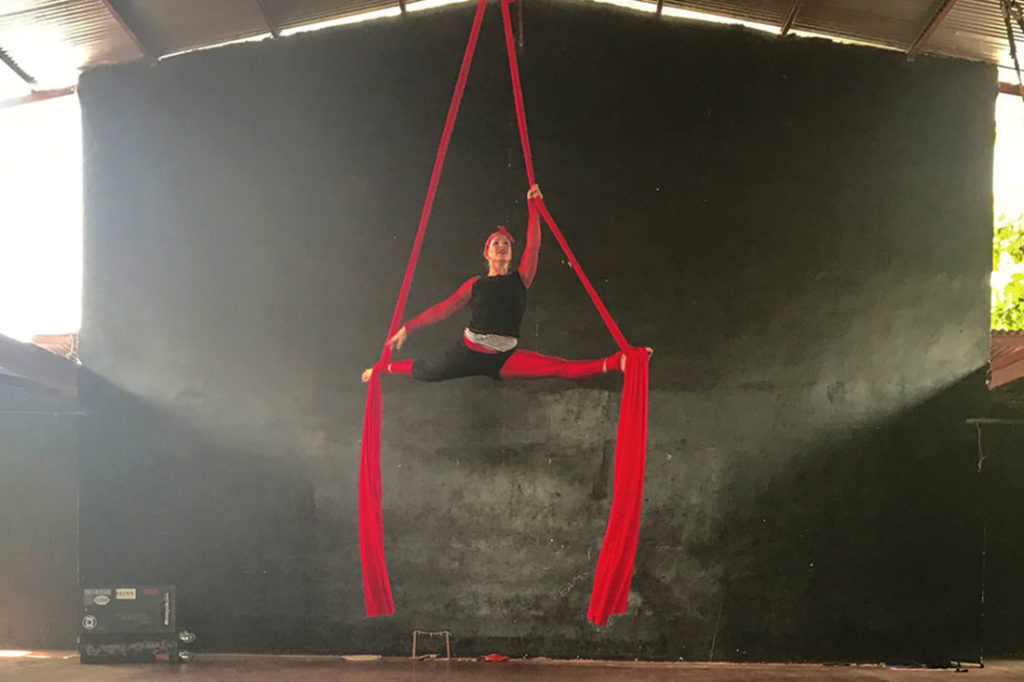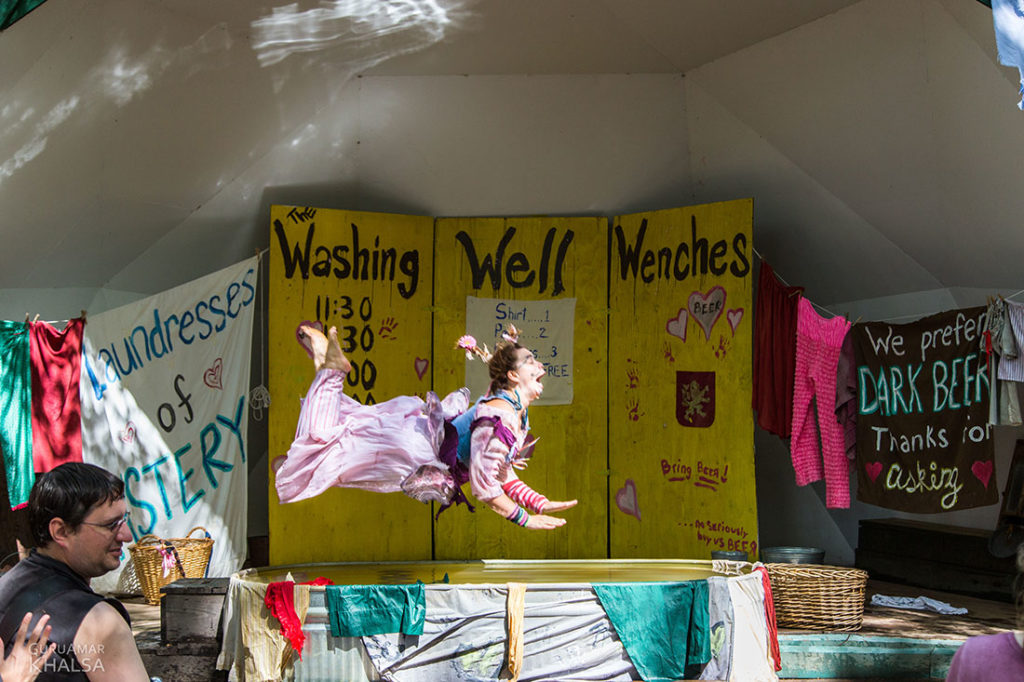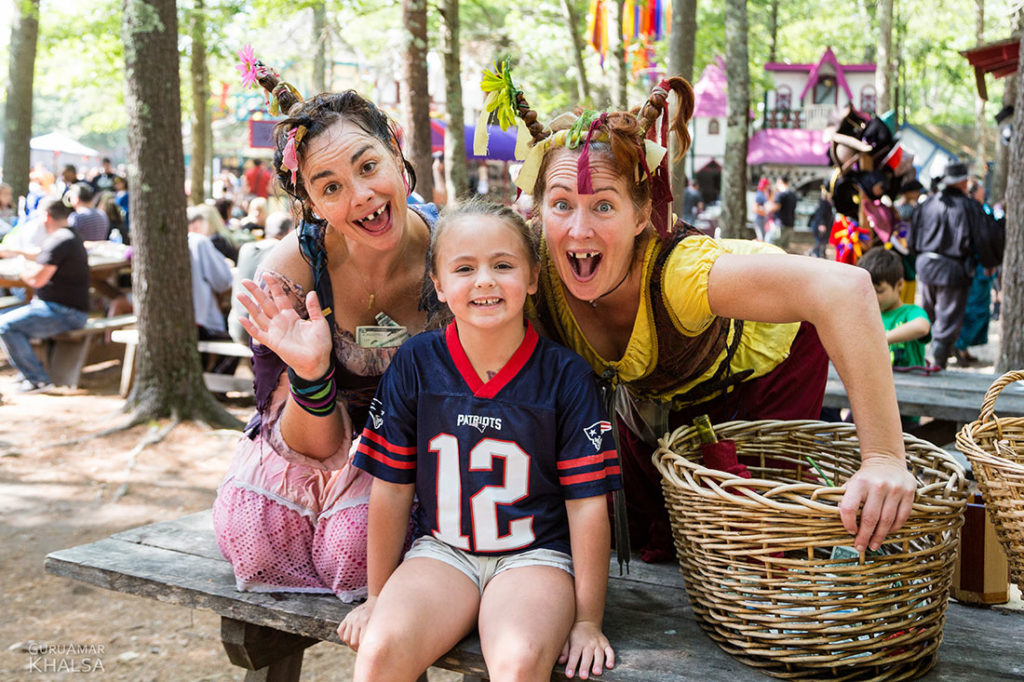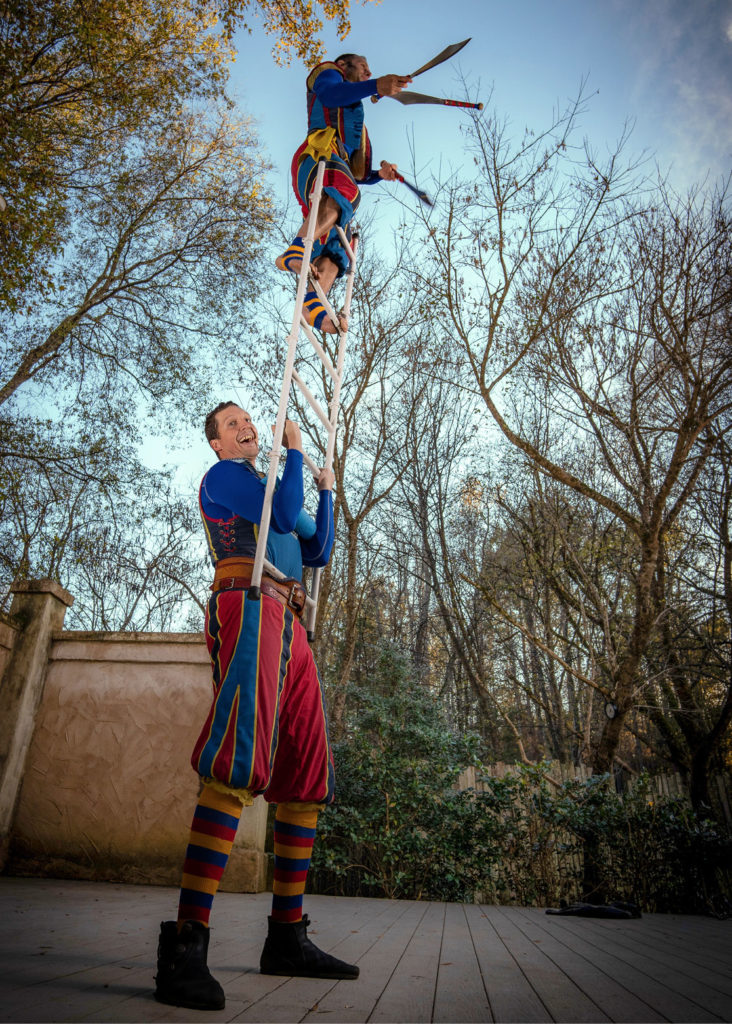My wife and I take our kids to the local Renaissance festival every year. I always come home amazed by something I saw—the woman doing the splits while hanging from silk curtains or the guy who shoves swords down his throat or the three-person acrobatic crew contorting themselves in ways that hurt just to watch.
It’s the modern-day version of running away to join the circus, but underneath the funny accents, outlandish outfits and crazy stunts is devotion to the performers’ obvious passions, which should inspire any entrepreneur. Many of them face the same day-to-day challenges that everybody in the YouEconomy faces, from negotiating contracts to finding new clients to knowing what to offload and what to do themselves.
Related: 5 Lessons Death-Defying Adventure Taught Me About Facing My Fears as a Solopreneur
On top of all that, they also push the bounds of dangerous, look for ways to keep their performances fresh and devote hours to sometimes grueling physical exertion.
They deal with more failure than anybody I’ve ever met. More important, they’ve learned to grow from it, even feed off of it.
They deal with more failure than anybody I’ve ever met. More important, they’ve learned to grow from it, even feed off of it. Indeed, without failure, they would be stuck in the Dark Ages. As I’ve talked with performers from Renaissance festivals across the country over the last few years, I’ve come to the conclusion that I can learn everything I need to know about being a solopreneur from them.
1. Pick a lane.
Full credit to Jaime Zayas: I got the idea for this story during his performance at the St. Louis Renaissance Festival. Specifically, inspiration struck as I watched him juggle while he was hanging upside down from a trapeze. If there’s a better metaphor for the solopreneur life than juggling while hanging upside down from a trapeze, I haven’t heard of it.
I wanted to know what kind of delightfully creative mind thinks, juggling isn’t enough, hanging upside down from a trapeze isn’t enough, I’m going to do both at the same time. I wanted to pick that brain for insight. As I watched, I marveled at how long it must have taken Zayas to learn to do that. How many times did he drop the balls, climb off the trapeze, pick them up, get back on the trapeze, and start over?
Jaime and his wife, Vanessa Waggoner-Zayas, call the not-for-profit through which they perform and teach “Kinetic Tapestry,” and their explanation for that name is as good of a definition of the YouEconomy as I’ve heard. Start with Kinetic—everything they do involves movement, nothing is ever static. The “Tapestry” refers to how they weave together performance-related threads—teaching, aerial acts, miming, acting, clowning, emceeing, juggling and so on.
“A lot of the artists that we’re training, those are threads. Artists that we’re collaborating with, those are threads,” Vanessa says. “If you look at a tapestry from the back side, it looks like a hot mess sometimes. But it’s all being woven, all these people’s lives coming in and out of our story.”
 COURTESY OF KINETIC TAPESTRY | ALONG WITH HER HUSBAND, VANESSA WAGGONER-ZAYAS MAKES UP ONE HALF OF KINETIC TAPESTRY.
COURTESY OF KINETIC TAPESTRY | ALONG WITH HER HUSBAND, VANESSA WAGGONER-ZAYAS MAKES UP ONE HALF OF KINETIC TAPESTRY.
When I went out on my own as a writer, a small business counselor hammered it into my head that I needed to “pick a lane” and stay in it. I bristled against that. My friends who are beat writers—the definition of “lane” in journalism—all hate it. My counselor assured me that my lane could be wide, but I had to have one, whether I liked it or not.
Jaime and Vanessa have wide lanes, too, and yet each distills their role into one word. For Jaime, that word is clown; the juggling, trapeze, etc. are tools he uses to be a clown. For Vanessa, it’s storyteller, and she tells stories through different modes of performance.
They try to make their lanes as wide as possible while staying in them. For example, they might get a call from a client who wants to hire a magician. Vanessa does basic card tricks and can perform those while mingling with the audience. She would propose that as an alternative to a magic show.
Kinetic Tapestry has grown by 30 percent in each of the last few years, and that has forced Jaime and Vanessa to face questions of capacity they have never had to deal with before. Now they have to more carefully choose which threads to put into their tapestry. That sometimes causes tension because they love to entertain. “You have to balance,” Jaime says. “More than money, we want to perform. We want to do the show. How low are you willing to go? Your desire is not just for the money, it’s because you want to perform. It’s what your heart wants to do.”
Sometimes they follow their hearts. They live in St. Louis, and Jaime is a big baseball fan. Two years ago, the St. Louis Cardinals hosted a Hispanic cultural celebration day. Jaime, who is Puerto Rican, called the team and offered to perform on stilts for the price of a couple tickets to the game even though he well knows tickets to the game don’t pay the grocery bill. “I just want to do that gig, for the fun of it. Now I can say, ‘Oh, they’re one of my clients,’ ” he says. (Side note: Saying “the Cardinals are one of my clients” in St. Louis is like saying “Disney is one of my clients” in a room full of kindergartners—instant cool factor.) “I do it because it’s stuff that I want to do. But you have to watch that you don’t undersell yourself, and people get used to that. That’s why you always have to balance.”
Which brings me back to Jaime juggling while hanging upside down from a trapeze. He couldn’t do that without incredible balance. Jaime got the idea when he was brainstorming new acts for the show—new threads to weave into their tapestry. He already could juggle by tilting his head back and throwing balls toward the ceiling. It occurred to him that he could use that same motion if he was hanging from a trapeze.
Considering he could already juggle, and he could already hang upside down from a trapeze, it didn’t take all that long to learn to combine the two. It looks much harder than it is.
2. Be trusting.
If the one word for Jaime Zayas is clown and the one word for Vanessa Waggoner-Zayas is storyteller, then the one word for Danielle Dupont is trust. Dupont is the founder of Washing Well Wenches, which has 24 actresses and performs at 34 Renaissance Festivals every year. “I trust the audience,” she says. “I trust the management. I trust the people that I hire. I let go of the details, and I trust.”
Early in Dupont’s career, the performers often gathered in a circle for trust falls. Dupont turned that up a notch. “I told my group, ‘Guys, do me a favor. When I fall backwards, I would love it if you guys sling me across the circle. Just sling me as hard as you can back and forth.’ They said, ‘What if we drop you?’ ”
That’s a fair question, to which Dupont responded, basically, who cares? Dupont says her sense of trust is not a naïve belief that everything will work out fine, it’s that even when things go badly—sometimes especially when they do—she will learn something valuable and come out stronger. “In my mind, the trust exercise is not that I trust you to catch me,” she says. “In my mind, the trust exercise is that I trust that I’m going to have fun, and that if I fall, I’ll probably survive, and I’ll have a much better time.”
Dupont has had to learn and re-learn the power of trust as Washing Well Wenches has grown to be “the largest and longest-running female-fronted comedy show performing nationwide on the Renaissance Festival circuit.”
 COURTESY OF WASHING WELL WENCHES | DANIELLE DUPONT FOUNDED THE WASHING WELL WENCHES TROUPE MORE THAN 30 YEARS AGO.
COURTESY OF WASHING WELL WENCHES | DANIELLE DUPONT FOUNDED THE WASHING WELL WENCHES TROUPE MORE THAN 30 YEARS AGO.
Most performers Dupont hires are based on recommendations, and she trusts that only qualified candidates are going to be recommended to her. Dupont says the show’s script is funny, so she doesn’t worry about hiring funny actresses. “What I really need is a wise, kind, compassionate girl, because they will trust the audience,” she says. “They will make sure the audience is having fun.”
One time a new hire wanted to call her character Eureka. Dupont, whose character name is Daphne, favors more old-fashioned names like Ruby, Pearl and Dottie. Eureka didn’t fit that mold. “I hated it,” Dupont says. “What I wanted to say was no. But I’m just not made out of that word. So I said, if you really want to. It hurt me to say, if you really want to, but I said it. This year her character has been around for 15 years, and she’s fabulous. I’m almost never going to say no. Even when my knee-jerk reaction is to say no, I swallow it. Buddy, if you think that is going to work, go for it. I cringe. I breathe through it, and I respect these people I have brought on board.”
Dupont lets Eureka, Dottie and the rest perform the script however they want. She gives them only two ground rules, both of which allow them to remain in the Washing Well Wenches’ lane. No, 1, stay in the time period—modern jokes and references would take the audience out of the moment. And No. 2, keep it clean.
 COURTESY OF WASHING WELL WENCHES
COURTESY OF WASHING WELL WENCHES
“People do all of the parts so differently,” she says. “As all of us look at the other girls doing the show, we go, oh, that’s cool, I never thought of doing it that way. Or oh, that’s a funny line. There are a lot of patrons out there that will go and find our show all over the country and see the different permutations. The spirit stays the same.”
3. Take chances.
Cameron Tomele remembers exactly where he was when he got “the call.” He was at a coffee shop in Lakewood, Ohio, when he received confirmation that he had landed the contract he needed to turn Barely Balanced, the comedic and acrobatic routine that he founded and had supplemented with side hustles, into a full-time job. “I had to stop for as second and take a few breaths, then go get a coffee and let it sink in,” he says.
The concept he imagined while day-dreaming in detention had become a reality. In the 15 years since then, he has faced all of the challenges that a solopreneur can face—from how to set prices to offloading tasks to keeping his skills sharp while simultaneously learning new ones.
In the show, Tomele is known as “Medium,” and he performs alongside his wife, Margret “Small” Ebert and Jimmy “Large” Freer. I saw them perform in five different years at the Carolina Renaissance Festival near Charlotte, and they were my “must-see” every year. Their shows were consistent in tone and content, but they were also different enough to keep me coming back. It’s like a great restaurant—it sells the same popular entrées, while always experimenting with specials. It keeps the ones that work and shelves the ones that don’t.
 JIMMY “LARGE” FREER OF BARELY BALANCED LIFTS CAMERON “MEDIUM” TOMELE IN “THE HERNIA-MAKER.” COURTESY OF BARELY BALANCED.
JIMMY “LARGE” FREER OF BARELY BALANCED LIFTS CAMERON “MEDIUM” TOMELE IN “THE HERNIA-MAKER.” COURTESY OF BARELY BALANCED.
Tomele sees many benefits to constantly changing the show. First, it’s a good business policy because it allows him to charge more as the show gets better. Second, it keeps fans coming back. And third, it keeps him, Small and Large from getting bored on stage and off. Working hard on the show makes the three of them work hard on the rest of the business. “It has a ripple effect,” Tomele says. “Creativity begets creativity.”
Tomele never knows where that creativity will come from or where it will take him. Barely Balanced’s newest stunt serves as a prime example. It came about the way most of their stunts do: A combination of diligent practice, precocious tinkering, and a light bulb moment borne of screwing around.
Start with the seven-rung ladder. The top rung stands maybe 10 feet off of the ground. Tomele spent a year trying to learn how to climb the ladder without it leaning against anything “and not fall to my death.”
One day, he was practicing on the ladder and told Freer, who is called Large for a reason, to lift the ladder while he was perched on top. The move took a lot of strength from Freer, but it made Tomele’s balancing act on the ladder easier. Plus it looked cool—Tomele was 15 feet up in the air. But the stunt still needed more. “The moments things get easy, we like to say, ‘How can we push the envelope?’ ” Tomele says. “Margret’s like, ‘Hey, how about if I throw stuff up to you for you to juggle?’ ”
It’s not enough for a trick to be incredible, it also has to be funny.
First she threw him balls, then clubs, then machetes. And that became the routine: Medium balances on a ladder. Large picks him up and holds him high. From 15 feet below, Small throws Medium machetes, and he juggles them. Asked if the stunt has a name, Tomele thought for a beat and said, “The Hernia-Maker.”
There’s no way to predict The Hernia-Maker or sketch it out ahead of time. It just happened, and that’s part of the fun. Small, Medium and Large spent months perfecting the trick and then workshopped it for a few shows trying to figure out the best way to present it, because it’s not enough for a trick to be incredible, it also has to be funny.
First they tried a Humpty Dumpty theme—Tomele was high up and might fall and break himself. That morphed into Tomele using the ladder like an elderly man uses a walker and declaring that no nursing home could contain him. It will probably change again. “Everything we ever do is always in flux,” he says. “I try to not think of anything we ever do as done. I’m always looking for that new thing we can add that’s going to make it funnier or weirder or more relatable.”
4. Embrace failure.
Here’s a dirty little secret: “The audience a lot of times doesn’t really know the really, really hard stuff from the moderately hard stuff,” Vanessa says.
For example? “Splits.”
I laughed when she said this, because when she did the splits while hanging from silk curtains held aloft by a crane, I applauded more than for any other part of the act. I would snap in half if I tried that.
“Everyone goes nuts when you do the splits,” she says. “It’s like a second-year, level two trick.”
“SHHH!” Jaime says, and they both laugh.
Whether they’re performing something “easy” like splits or difficult like the Hernia-Maker, some performers strive to be perfect on stage. But the only way to be perfect on stage is to fail over and over again in practice. Some struggle with that. Vanessa often tells her students a story about how for years she refused to go skiing because she was afraid she would fail at it. “I finally went and loved it,” she tells them. “I was so sorry that I had missed all those chances to go skiing because I was so worried about how it was going to look.”
She then asks her students how they think she fared as a skier. “They say, ‘great.’ I say ‘NO! I fell on my butt for four hours!’ But I kept at it, and I kept falling down, and gradually, little by little, by the end of that day, I was starting to get halfway down the bunny slope.”
And the on-stage equivalent of falling on your butt can be turned into a positive if handled correctly. When I saw Kinetic Tapestry perform, Jaime dropped a ball while juggling (while standing up!) He made a joke, picked up the ball and started juggling again. I half-wondered if he dropped it on purpose. He didn’t. He sees a dropped ball not as a failure but as an opportunity to let his inner clown come out.
For a dangerous stunt, Small, Medium and Large of Barely Balanced practice until they can do it virtually 100 percent of the time. But they don’t need to always be flawless on stage. “We like to have (mistakes) in our show every now and then,” Tomele says. “It reminds the audience of the danger, the risk, that things can go wrong. If we can safely handle a mishap, that hammers home the reality.”
Sometimes, in fact, the mistakes are the most memorable parts of the show. “It is super freeing,” Tomele says, to not require perfection.
That’s quite a sentiment from someone who spends his time juggling machetes while perched atop a ladder that’s hoisted 15 feet in the air. But it’s an idea a lot of solopreneurs can embrace. After all, the show must go on.
Related: 3 Emotions All Entrepreneurs Feel (and How to Keep Them in Check)
This article originally appeared in the Summer 2019 issue of SUCCESS magazine.
MAIN PHOTO COURTESY OF WASHING WELL WENCHES










